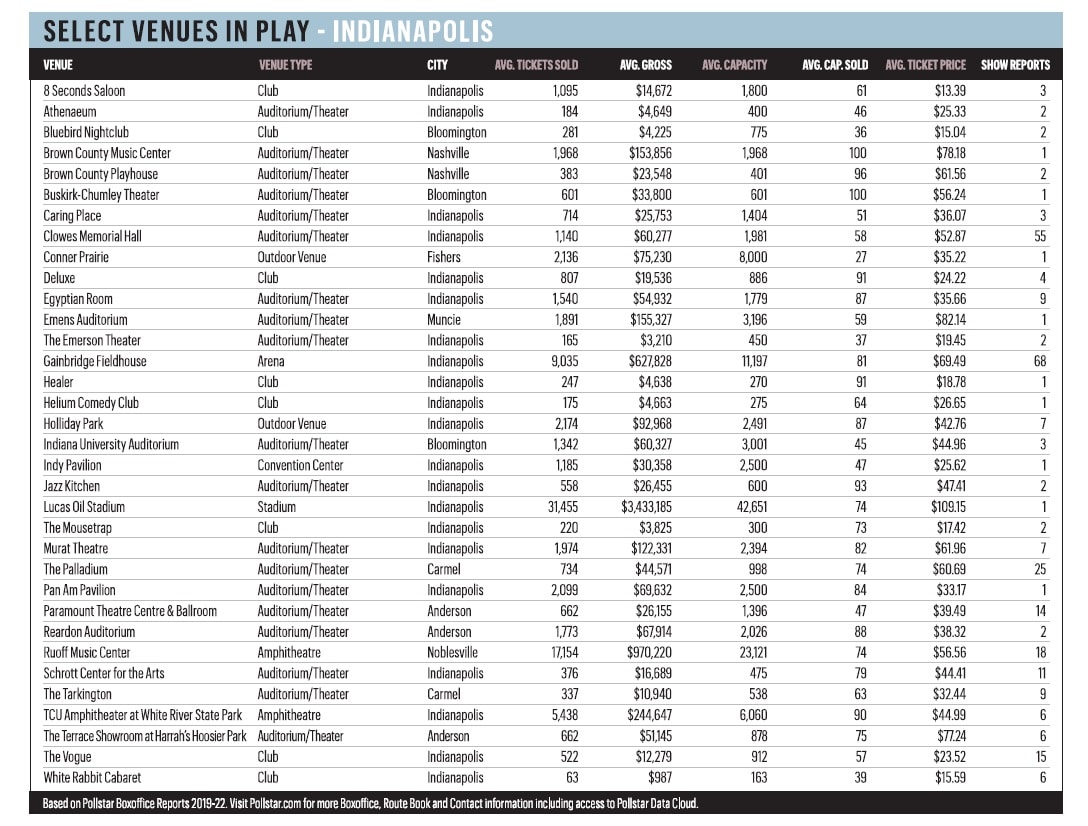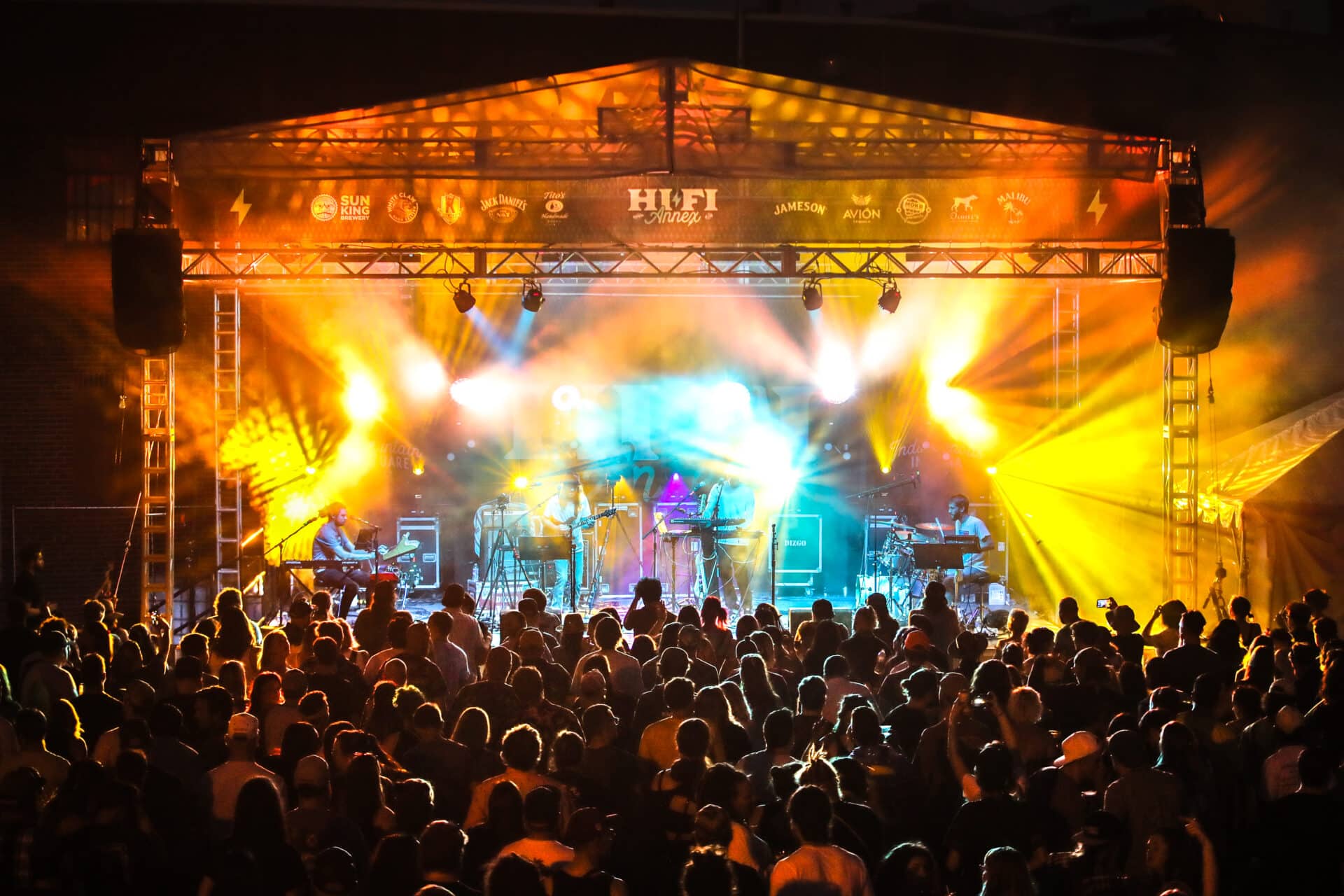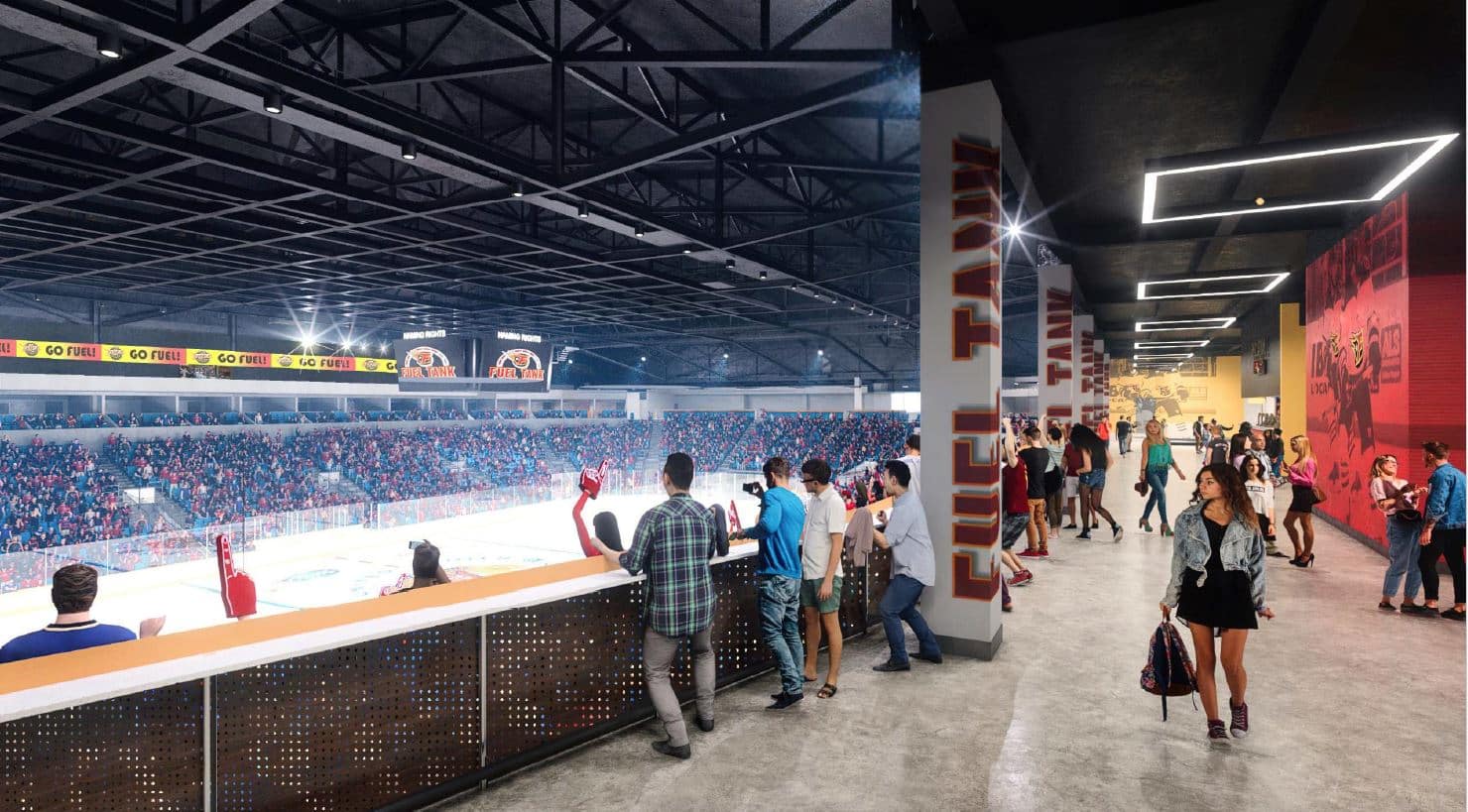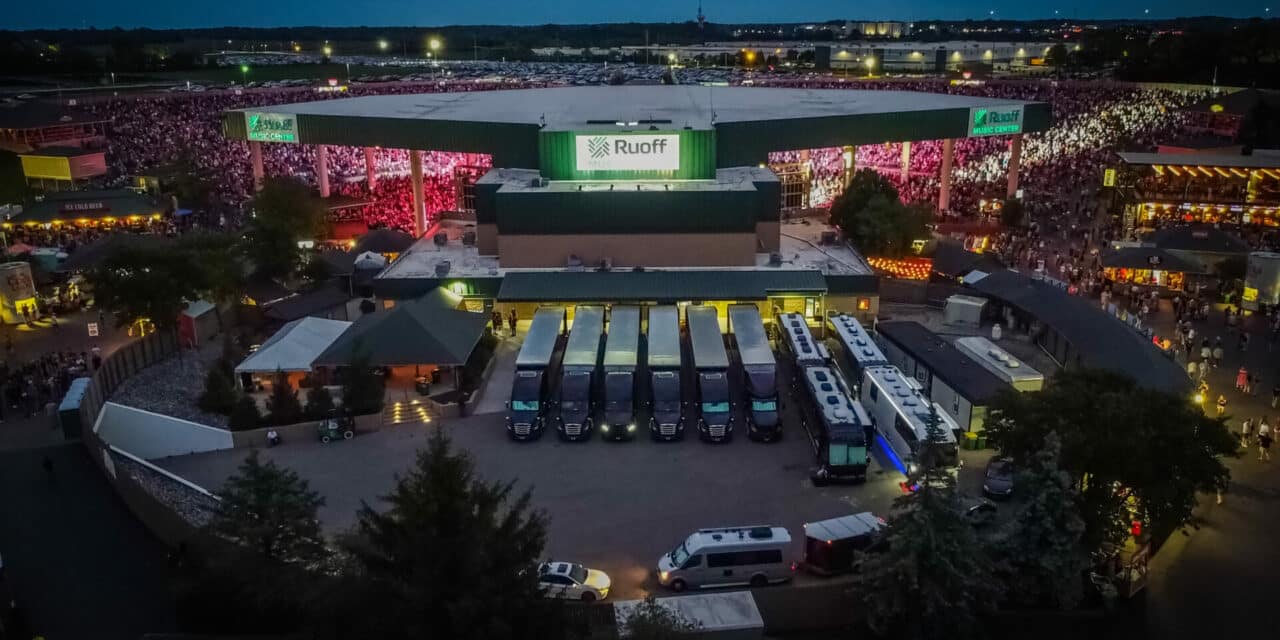First, There Was Corn: Ruoff Music Center, one of the largest and most active concert amphitheaters in the country, opened in Noblesville as Deer Creek Music Center in 1989. (Courtesy Live Nation Indiana)
Home to the NFL Indianapolis Colts, the Indiana Pacers, the NCAA and USA Gymnastics — not to mention the Indianapolis 500, considered the largest single-day sporting event in the world — Indianapolis has long been established as a sports capital of the U.S.
“Everyone knows Indianapolis for the Indy 500 and NCAA basketball and the Pacers, but there’s a few of us out here trying to show that music can be just as much of an economic engine as sports and racing,” says WME’s Justin Edwards, who was promoted last year to agent and books the agency’s clients for rock and alternative music festivals.

Although based in Nashville, Edwards happens to be from the Indianapolis area. With a flurry of development in recent years, including the opening of new clubs and projects like the $1 billion Eleven Park taking shape (see Dossier on page 54), Edwards says his hometown market is becoming a lot stronger on the touring side.
“For a long time it was tough, because tours would miss out on playing Indianapolis proper because it was hard to get weekend avails lined up, and that’s when a lot of people were trained to go out to shows because it was cumbersome to go out during the week,” said Edwards, who also represents clients or is on the team for established artists including The Revivalists and Dinosaur Jr. as well as developing bands like The Main Squeeze and GUNNAR.
“Over the span of the last 10 years or so, with the Hi-Fi opening up in Fountain Square and providing an area for up and coming bands to play, they’ve built up the infrastructure and built a music farm system from the ground up,” says Edwards, mentioning locally based promoters and venue owners such as MOKB Presents and festival producer Elevation Festivals, which is staging the second edition of WonderRoad festival at Garfield Park June 17-18, headlined by Weezer and Jason Isbell.
The Hi-Fi opened in 2014 and doubled its capacity in 2017, bringing a much-needed 400-capacity club to the region, after which a band can go on to larger clubs like the 800-capacity Vogue Theatre.
“The volume of what we are seeing coming through the marketplace is huge,” says Dan Kemer, a partner in the Hi-Fi and MOKB Presents, which launched in 2008 and has put on more than 2,500 events, most in Indiana. Kemer ran Live Nation’s Indiana office before the pandemic led to staff cuts, after which he became a partner in MOKB headed by Josh Baker.
“Last year you saw the most tours out on the road, and we all thought that maybe 2023 might be a little bit lighter, but it hasn’t slowed down at all,” adds Kemer. During the pandemic, MOKB introduced an outdoor space at the Hi-Fi’s parking lot, which has developed into a 900-capacity outdoor space called the Hi-Fi Annex. Also containing the 100-capacity “listening room” known as the Lo-Fi, the new outdoor space gives further flexibility for touring bands.

“It’s not just the club stuff,” adds Kemer who, in a separate role, handles programming for the nonprofit Center Stage Presents based in nearby Carmel, Indiana, which includes the 1,600-seat Palladium theater,
the 500-capacity Tarkington theater and a 200-seat black box theater.
“We probably have 60% of our 2023-2024 season booked, which we’ll be announcing in May,” Kemer said. “Across the board everyone still wants to be out and, knock on wood, people are still going to see shows, which is great.”
MOKB also put on an eight-show series over the summer of 2022 at Nickel Plate Amphitheater District in Indy suburb Fishers featuring The Avett Brothers, Gov’t Mule and others.

More Outdoor: The Hi-Fi Annex is new outdoor space at the Hi-Fi Indy complex, which now contains three ticketed venues of different sizes and is seeing increased touring business.
Live Nation Indiana has a strong presence in the region, running amphitheaters, clubs and theaters in town.
At 24,000 capacity, Ruoff Music Center in nearby Noblesville has been a strong destination since opening in 1989, when it was called Deer Creek Music Center.
“It was truly built in the middle of a corn field back in the ’80s, and then all these housing developments sprung up around it because people liked the area, and suburbia followed suit,” says Edwards, who said the shed is a summer staple for locals, many of whom attended their first concert at the amphitheater. “It’s one of the biggest country markets in America by volume.”
Dave Matthews Band typically does an annual two-night stand at Ruoff, which also typically plays host to popular jam bands, starting with multi-night runs by the Grateful Dead in the ‘90s.
That history has given way to not only new venues and increased tour stops, but new events as well, with WonderRoad festival returning for year two.
“We’re the boots on the ground for WonderRoad,” says Kemer, who adds that MOKB Presents has 18 full-time staff. “Our part was helping with site selection, talent, working with the city, working with Visit Indy, connecting all the dots for Elevation out of Cleveland to make sure that we were hitting on all cylinders.”
While festivals can be economic drivers attracting tourists from out of state, WonderRoad has a decidedly Indy feel, with local talent filling out the lower portion of the bill and local radio station WTTS having a strong presence and helping get the word out to local music fans.
“For me, it’s been a major bucket list item to be able to give back to the Indiana music scene in the community,” adds Edwards, who oversees WonderRoad for WME as well as All In Music Festival in the city. “For a long time, the Indianapolis market, for whatever reason and to no one’s fault, struggled with getting a festival off the ground. It’s been a great partnership with the city, just helping them get a festival that people are really excited about. Not to say that they weren’t about others, but this seems to resonate really well with this music market.”
Despite the growth of the live music community, sports still rules in Indy, with the Indianapolis 500 held every Memorial Day weekend. Next year in particular, is shaping up as a blockbuster for Indy sports.
“It’s going to be a huge year for the city,” said Sarah Myer, chief marketing officer at Indiana Sports Corp.
The city will play host to the NBA All Star Weekend at Gainbridge Fieldhouse; the annual NFL combine at Lucas Oil Stadium; the NIT men’s basketball tournament at Hinkle Fieldhouse; and the U.S. Olympic Trials in swimming, the first time that event will be held in a stadium.
Gainbridge Fieldhouse, home to the NBA Indiana Pacers and an active concert venue, has undergone a three-phase, $360 million transformation that touched all parts of the building as the team gears up to host the All-Star Game.
The city itself is working to keep up with the demand, as Myer says Indianapolist itself is at 97% capacity for apartment living and adding more housing units, while the city’s convention center is working to expand, with a 50,000-square foot ballroom and an additional 94,000 square feet of exhibit space.
“They’re definitely adding hotels, too,” she said.
Increased infrastructure along with a greater number of venue options brings further momentum to the city as a tour destination and a building block for artist development.
“I’ve tried to be a champion over the years to get our staff in the know about what clubs are available,” WME’s Edwards adds. “I do feel like we’re fully up to par now and, and enough of us have done shows in the Hi-Fi to understand there is a really nice rock club in the region that’s dependable, that we don’t have to worry about deposits coming in.
For a long time, it was a little bit shaky with Indianapolis up until you hit the Live Nation level of their 800-cap. club.”

Gimme Fuel: The Indianapolis suburb of Fishers is getting a new $170 million event center, which includes a 7,500-hockey arena for the ECHL’s Indy Fuel.
Go Fish(ers):
$170M Sports And Entertainment Center To Include 7,500-Seat Hockey Arena
ASM Global is to provide pre-opening services and management for a new $170 million sports and entertainment center in Fishers, Indiana, that includes a 7,500-seat arena. It’s set to open in December 2024.
The arena will feature 23 suites, premium loge club seating and lounges. It will be home to the ECHL’s Indy Fuel and host concerts and other events.
Expected to break ground in March, the project is situated on 53 acres that expands on the recently developed 18-acre Fishers District including restaurant and retail options. The district is part of $1.1 billion in economic and entertainment investments announced in September. The city of Fishers is funding the project.
“From our standpoint, this is a great opportunity for ASM Global,” says Harry Cann, senior vice president of business development for ASM Global. “Fishers is a vibrant, growing community and this is a premier project in our mind.” Cann explains that pre-opening services for the arena include design consulting and supporting the team on commercial sales opportunities including naming rights and premium seating.
“Our sweet spot as a company is helping to elevate multipurpose venues and arenas and in strong secondary markets like Fishers where we utilize our resources, our network and our relationships are leveraged to elevate the programming and overall customer experience,” Cann adds.
“As a company, we’re coming out of COVID with tremendous momentum under Ron Bension, our CEO’s leadership, new people, new initiatives, expanded resources and a startup mentality that the new event center and the city of Fishers will benefit from beyond the walls of the arena to the broader district, the businesses and the local community.”
The event center is being designed by SCI Architects, with AECOM Hunt managing construction. Thompson Thrift is the developer. Cann says Fishers is a thriving, rapidly growing community akin to the suburbs in Gwinnett County outside Atlanta.
“We did our homework on this market and the response we received from the live entertainment industry, specifically the decision makers, was very positive in terms of the market potential,” Cann said. “There was a consensus that a 6,000- to 8,000-seat indoor venue was missing. There was a void in the market that this venue will fill. The response from the industry was overwhelmingly positive and only supported our confidence and our ability to perform for the city and the community moving forward.”







